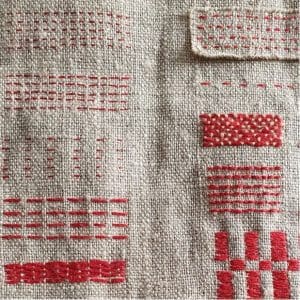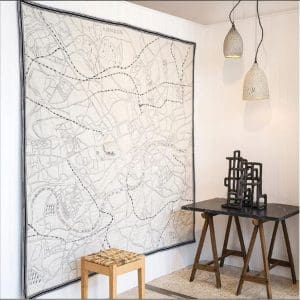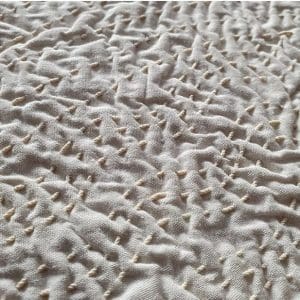If the adage ‘a stitch in time, saves nine’ could be applied to any craft form, it would be to the folk art of kantha embroidery. The textile tradition, where the humble running stitch plays a starring role and fuses layers of fabrics into embroidered wonders, derives its name from the word ‘kantha’, which roughly translates to ‘rags’ in Sanskrit. While the craft can be traced back to pre-Vedic times, it’s the rural women of Bengal who have kept this tradition thriving, repurposing and stitching together layers upon layers of soft saris and old dhotis with a reinforcing running stitch, using motifs depicting birds, animals, fish, folks stories, mythological characters, etc, to tell a graphic tale.
Using kantha to tell her creative story (albeit in a modern, interpretive way) is London-based textile artist Ekta Kaul, who creates ‘StoryMaps’—narrative cartographic textile maps “that explore places, histories and belonging through stitch.” The National Institute of Design (Ahmedabad) graduate uses the versatile running stitch to create monochromatic pieces of art that are housed in several collections, including those at the Gunnersbury Museum, Liberty’s of London, Chiswick Library and of private collectors. Here, she gives us some insight into the folk form and her continued fascination with it.
Tell us about the origin and history of kantha embroidery.
Kantha originated in the Bengal region of the Indian subcontinent (present-day West Bengal and Bangladesh). The feminist in me gets rather excited looking at vintage kantha, knowing that these beautiful textiles were created exclusively by women. Traditionally, kanthas were given as gifts to celebrate life events, often from the mother to daughter. Women recycled their old clothes and textiles, painstakingly turning them into quilts for children, bed covers, blankets, handkerchiefs, covers for furniture, etc. Interestingly, this spirit of celebration in kantha is quite different to boro textiles from Japan, although boro also employs similar stitches and layering of old textiles. Pragmatic, frugal yet beautiful and celebratory, kantha are beautiful inside and out.

Are there different types of kantha, and how do they differ in style?
Running stitch and its variations exist in embroideries of several regions in India including Bihar, Uttar Pradesh and Bengal. Over time, kantha developed into a variety of end uses and has specific names referring to its end use. Some of these include the quilt (called lep in Bengali), a large spread (nakshi kantha), cosmetic wrapper (arshilota), puja floor spread (ason), wallet (batwa, thoiley), clothes wrapper (bostani) and floor spread (galicha), among others.
How did kantha become your mode of creative expression?
I create ‘StoryMaps’, which are narrative cartographic textiles in stitch. Kantha is one of my favourite stitches to use. I love its simplicity, provenance and ethos. Despite its simplicity, kantha is an incredibly versatile stitch. It can embellish as well as join layers, and appears in several avatars within my work—as a line, a motif or texture on my textiles and as graphic marks on my paintings.

London Story Maps
What was your first encounter with the craft?
I encountered kantha saris for the first time in my mother’s wardrobe. She was a scientist and a prolific collector of saris. Whenever she travelled to West Bengal for conferences, she used to return with suitcases full of the most exquisite kantha, baluchari and jamdani saris. I distinctly remember being drawn to her kantha saris’ monochrome palette, something that still inspires my work today.
What, according to you, makes kantha such a handy tool in the sustainable fashion sphere?
I love kantha’s ethos of mending, repurposing and upcycling. Traditionally, old saris and dhotis were layered and embroidered with threads pulled out from the borders and repurposed into functional or decorative textiles. This is the very definition of green design, which is something we need more of in our current times of fast consumption and burgeoning landfills.

What will your upcoming workshop at the Victoria and Albert Museum involve?
I am also an educator, and see sharing my skills as an important element of my practice. I believe we can learn so much by revisiting tradition. My approach is to develop contemporary expressions by using the vocabulary of time-honoured techniques. At the V&A workshop, participants will study exciting examples of kantha textiles from the museum’s world-class archives. I will teach them the various stitches used in kantha textiles. Then I will guide the participants in developing their individual creative responses through drawing, mark making and embroidery. It promises to be a really exciting day of being immersed in unhurried learning, developing creativity and enjoying conversations with like-minded textile aficionados. I feel so happy to be bringing this unsung textile to a wider audience.

Ekta Kaul

